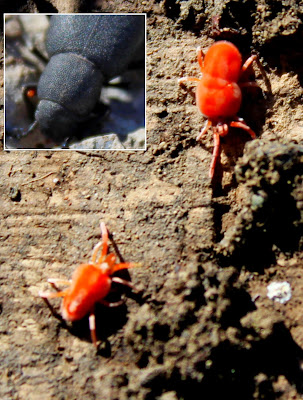In
previous weeks we've been back in time 800 years and joined the
Venetians in their hill fort at Monte
Forte and 2,000 years with the last of the Minoans at their place
in Praesos.
This week we're going back over 20 million years into the geological
past to a beach that you will no longer find in any good beach guide
to Crete. Lift a little patch of this massive slab of rock with your
fingers (which is surprisingly easy to do) and you can rub the sand
away from the underside with your thumb. It's covered with various
lichens on the surface but let's go up and see what plants have
colonised the edges. Plenty of Heather, as you'd expect on a sandy
soil, and down among the roots some beautiful little autumn flowering
Narcissi. We also have some spherical heads of Alliums. Garlic,
onion, chive and shallot are all Alliums and we have about fifteen
different species growing wild here on Crete. As to which these are
I'd have to check with our botanist friend, Steve Lenton who is a man
who really knows his onions. I never could get the hang of them: when
I was a young man I disappointed my future father-in-law by confusing
his onions with his gladioli but in fairness his vegetable plot did
abut his flower border.
We
also have plenty of stones and rocks for flipping which, as you know,
can keep me amused for hours. Oh look, our first beetle of the
autumn. In fact, this is quite a rare one called Pimelia
minos, which is
endemic to this end of the island and fairly easy to recognise as his
back has the appearance of avocado pear skin. I've only come across
this species twice before; on Koutsounari beach and at Bramiana
resevoir. Pimelia
may be a rare species but he is one of a group of 20,000 or more
Darkling Beetles that can be found worldwide very often in dark
places such as under stones which gives them their common name.
Now
who do we have here pollinating our heather? This is one of the
Tachinids, a rather bristly bunch of flies as you can see. They have
a tendency to lay their eggs in the larvae of other insects,
particularly the caterpillars of butterflies and moths, but some
prefer adult beetles or their larvae so it's no wonder our Pimelia
friend likes to spend his time hiding under rocks. So would I.
I've
found some old bricks over here. Let's rummage. You've got some
little orange dots moving about on the bottom of that one. Here, take
the hand lens and tell me what you see. They're sort of peachy? Nice.
How many legs have they got? A very small, eight legged creature with
peachy skin. May I take a look? What you have there is a Red Velvet
Mite, quite pretty in their own way but rather predatory when they
are adults. In their earlier life stages however they are parasitic
on other insects. I've just found another Pimelia
over here and look
what's nestling in the crook of his front leg, a little velvety
orange dot. Poor old Pimelia,
he's not safe anywhere.
Well,
what do you think? Quite a lot of life for a bare stone slab isn't
there? But there's another strange creature that I want to introduce
you to and you'll be pleased to hear that it is best observed from a
small taverna in the nearby village of Sikia. You'd have thought that
with so many wonderful creatures in the world there would be no need
to make them up but mythology is full of them such as that lovely
mermaid over there. If you are crossing the Aegean in a boat you may
meet up with Alexander the Great's sister, Thessalonike, who was
turned into a mermaid after her death. If she asks after her brother
tell her that he's alive and doing well. This seems to pacify her. If
you tell her he's been dead for centuries she gets all upset and
starts churning up the waters.
The
Extra Bit
The
trailcam has been busy photographing Great Tits and Italian Sparrows
galore during the day but this little fellow appeared overnight. He's
a Black Rat, Rattus rattus. I'm
not too worried about the occasional Brown rat around the garden but
I'm not so keen on having the black ones about. However, as the
trailcam also picked up three different cats investigating the bird
table at night it is hoped that he won't stick around too long.
Photographic
Bit
Many
of you have asked
me what
photographic equipment I use so here's a quick rundown on the cameras
used for each picture. For details of aperture settings, shutter
speeds etc. my pictures will be on Flickr
within
a few days and that has all the geeky stuff.
Picture
1 Canon EOS 1300D
Insets Canon
EOS 1300D
Picture
2 Canon EOS 1300D
Insets Canon
EOS 1300D
Picture
3 Canon EOS 1300D
Insets
Picture
4 Canon EOS 1300D
Insets Canon
EOS 1300D
Picture
5 Canon EOS 1300D
Insets
Extra
Bit Trail Camera RD1000
Pictures
were edited with FastStone Image Viewer and combined with Microsoft
Paint.
*********************************************************************
LINKS:
Share
your nature thoughts, photos and comments on Naturalists (the
facebook page that accompanies this blog)





Great stuff!
ReplyDelete